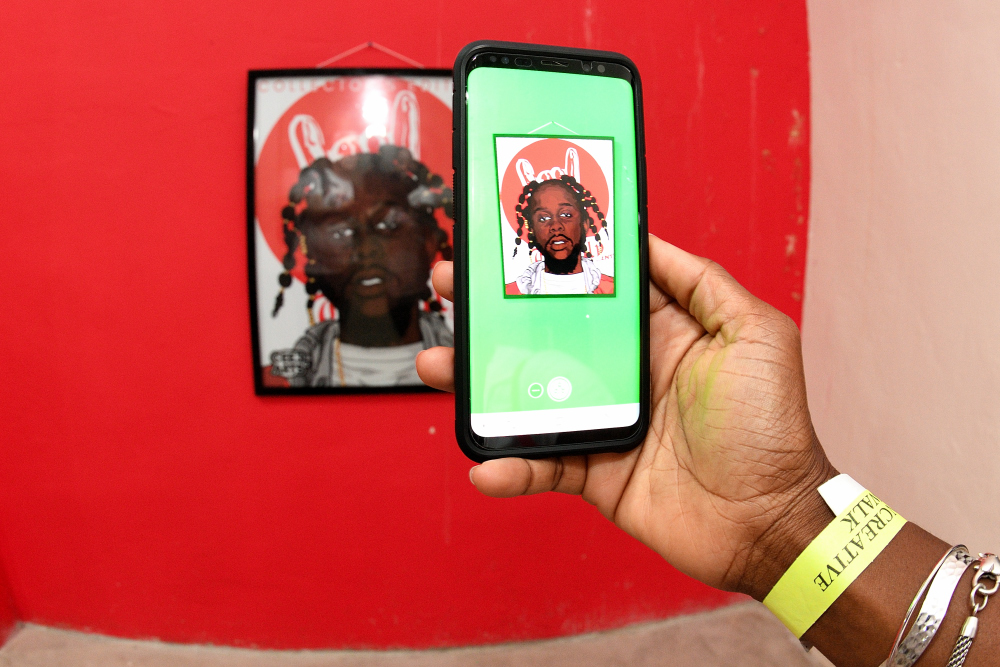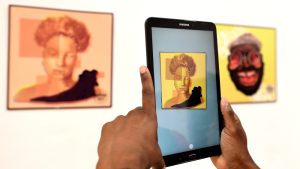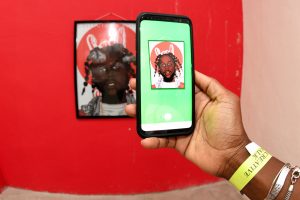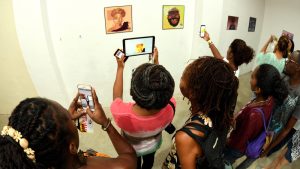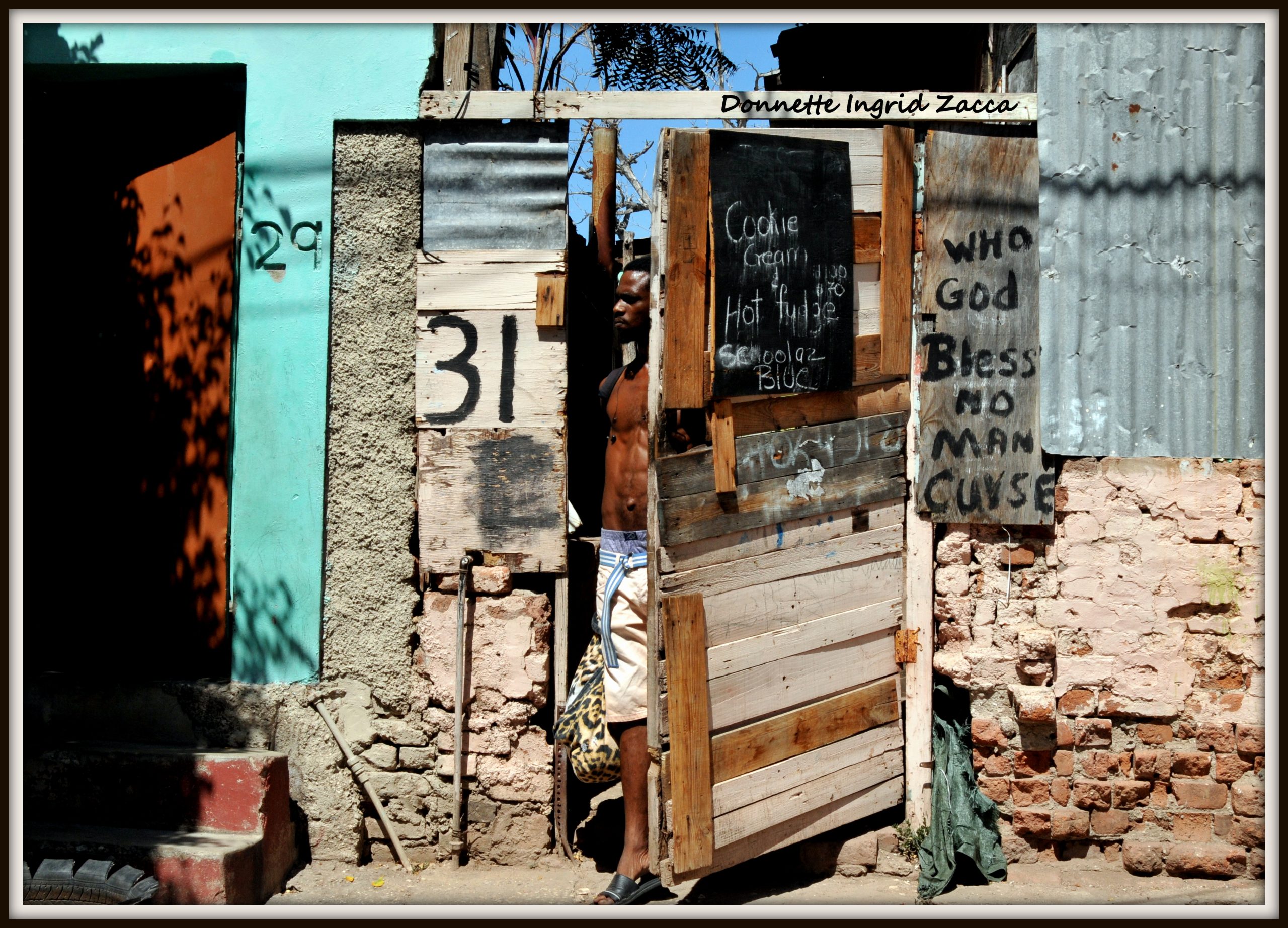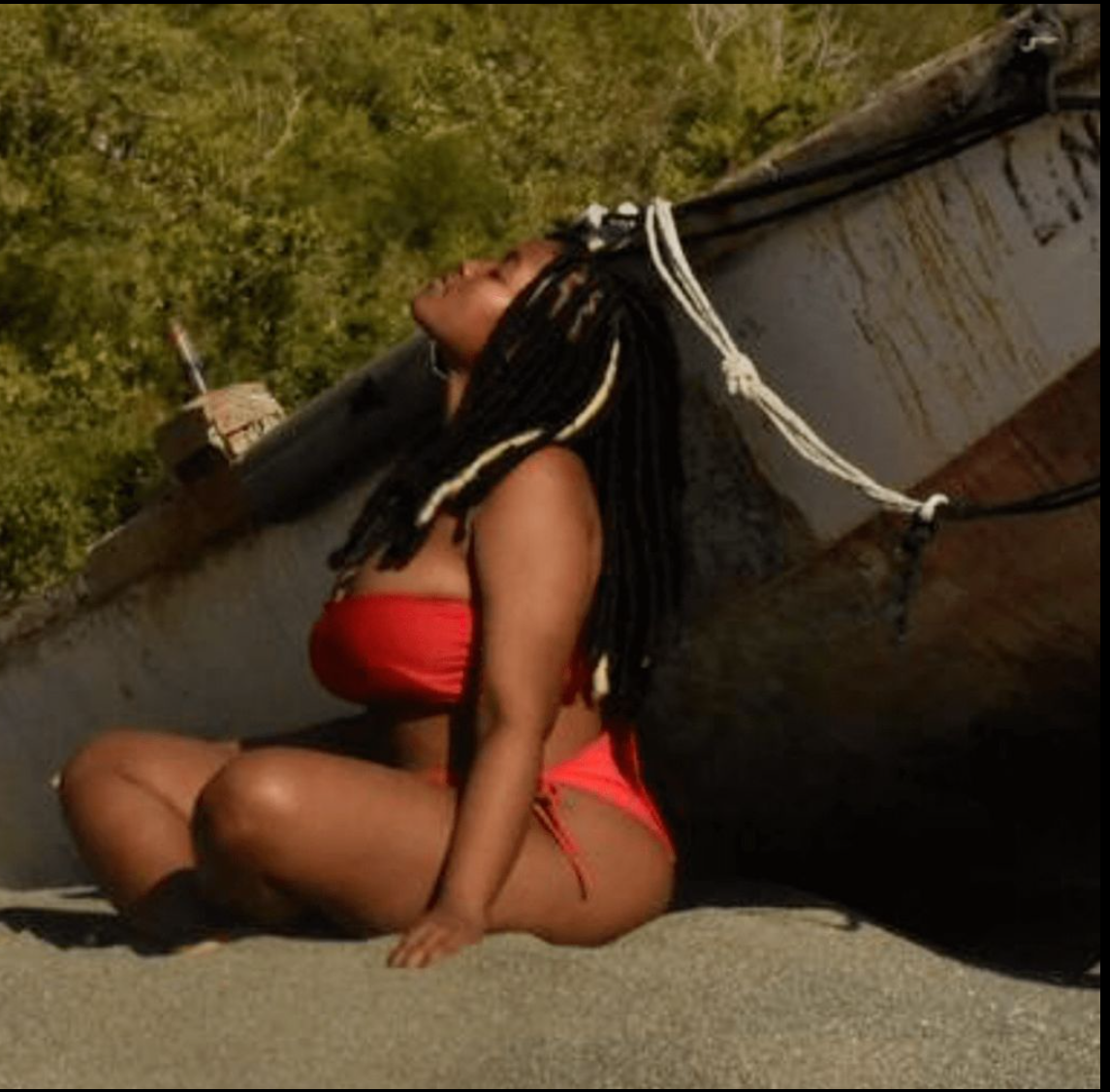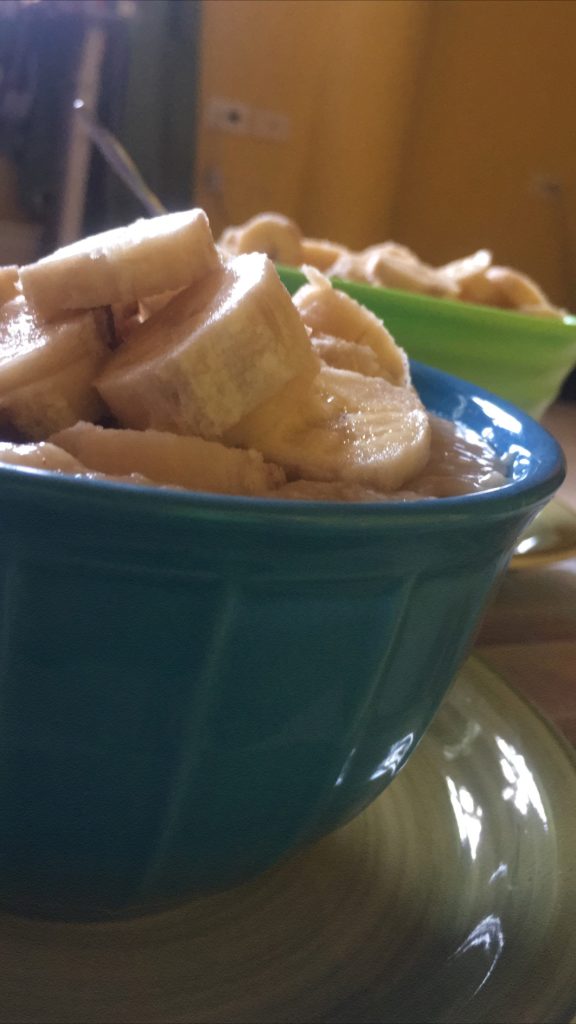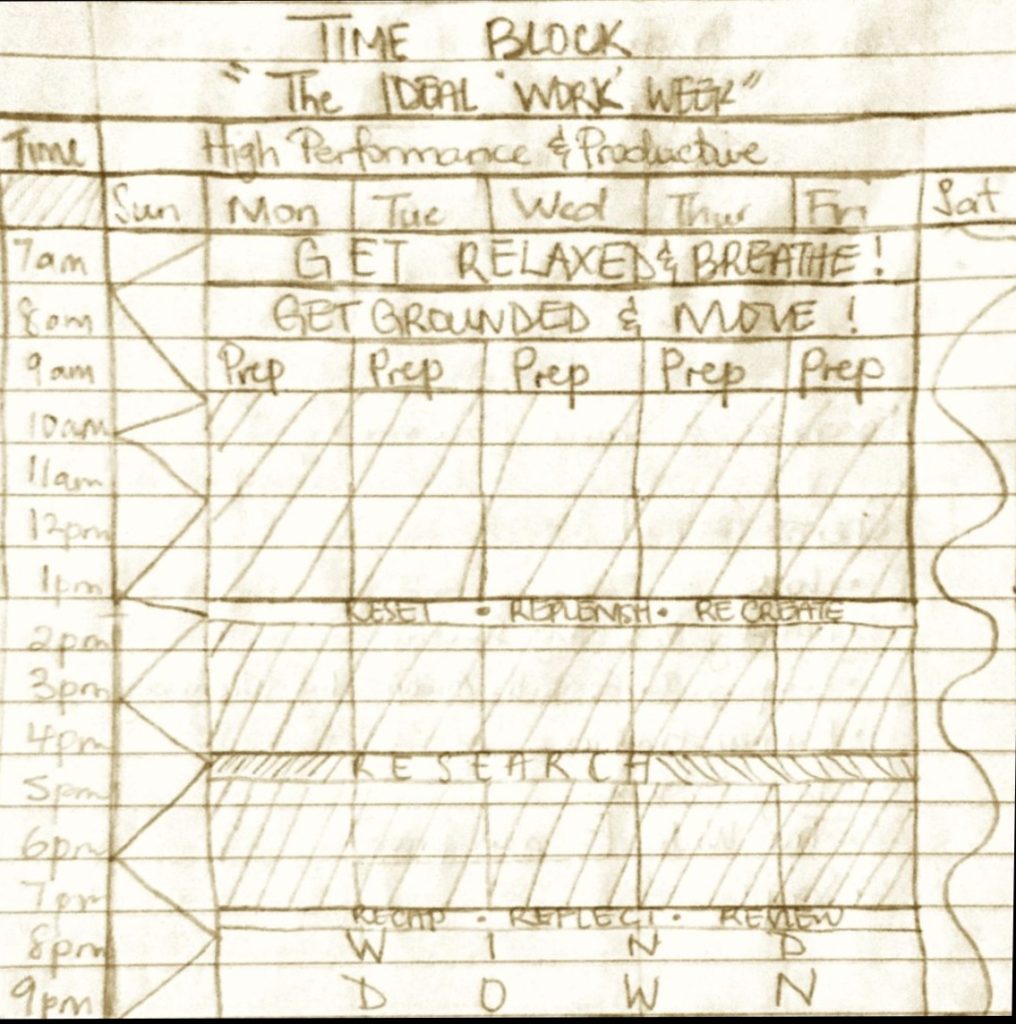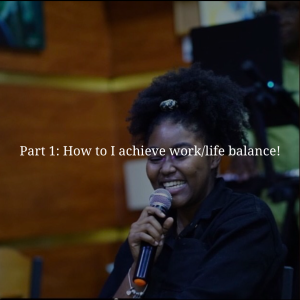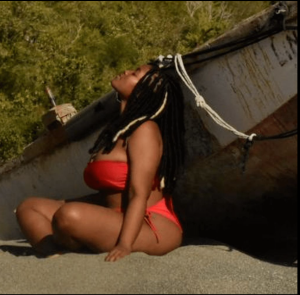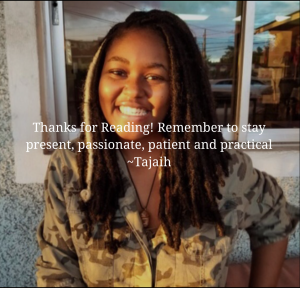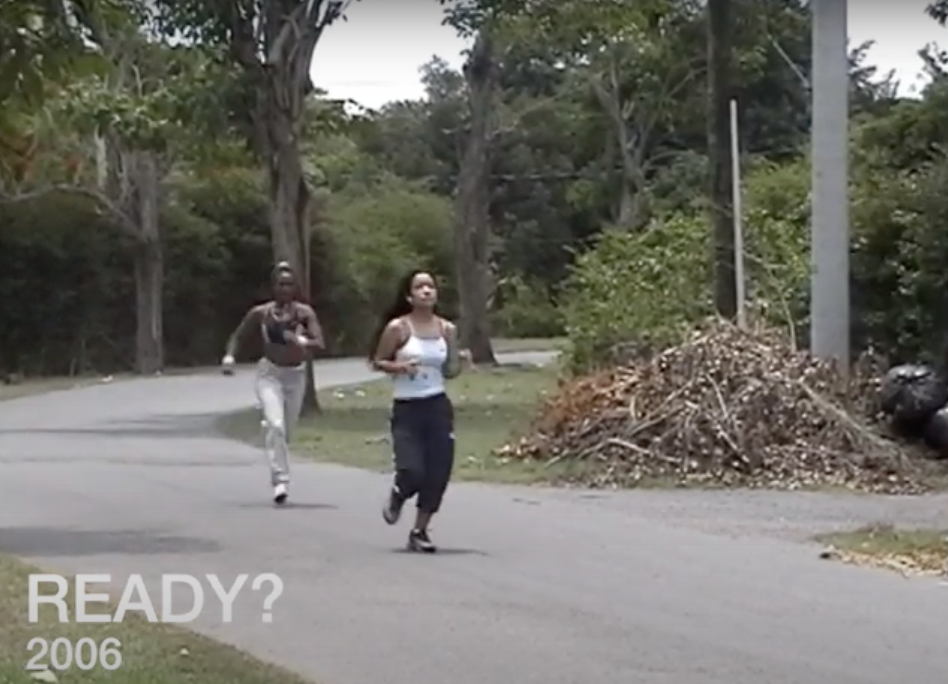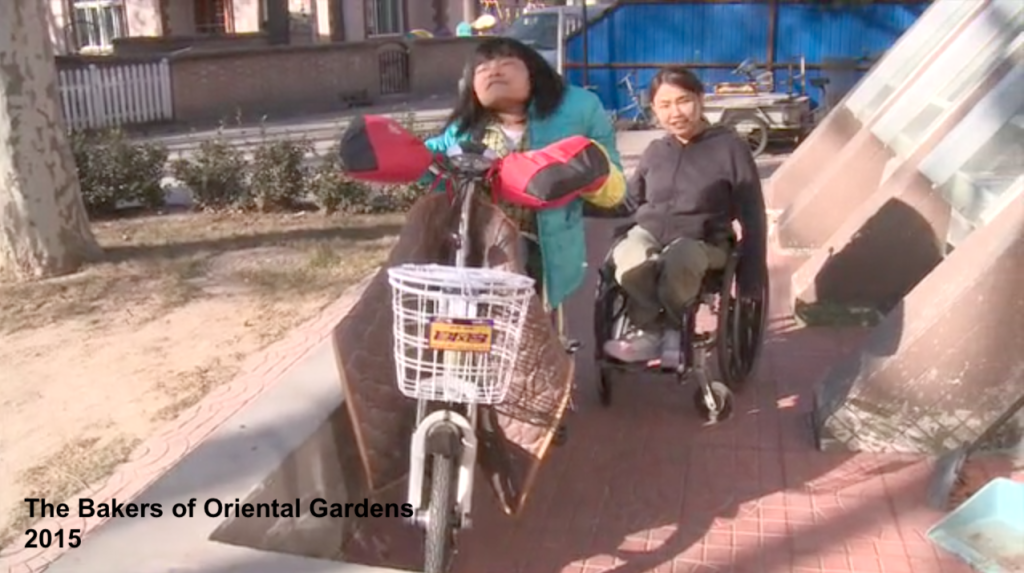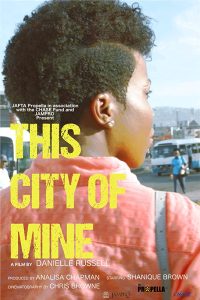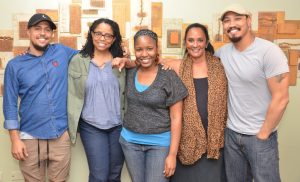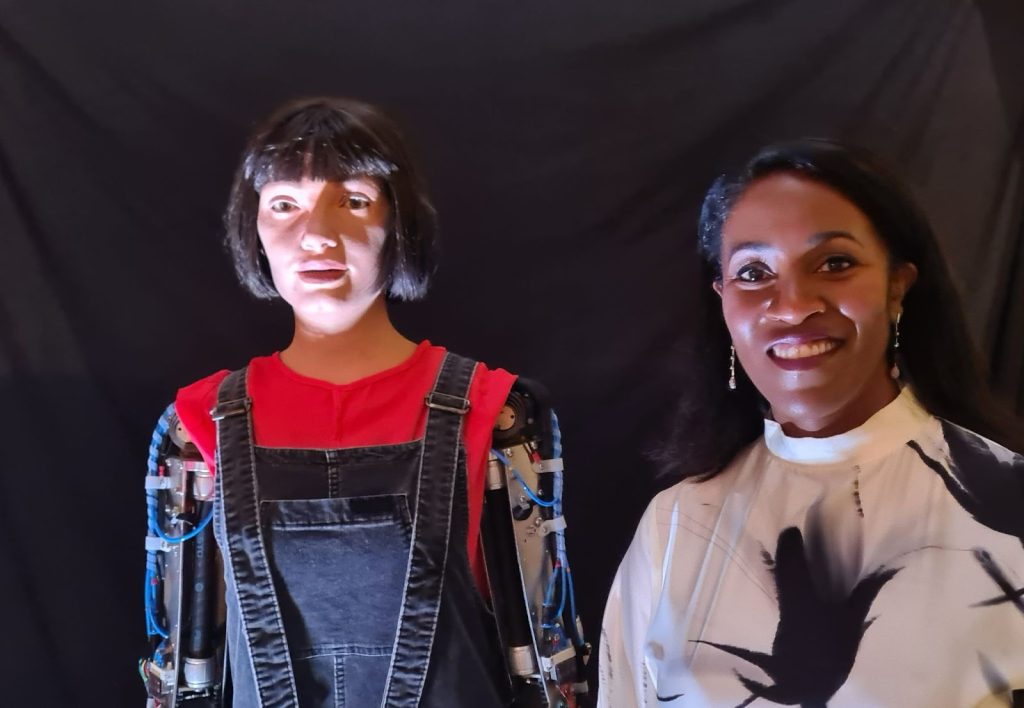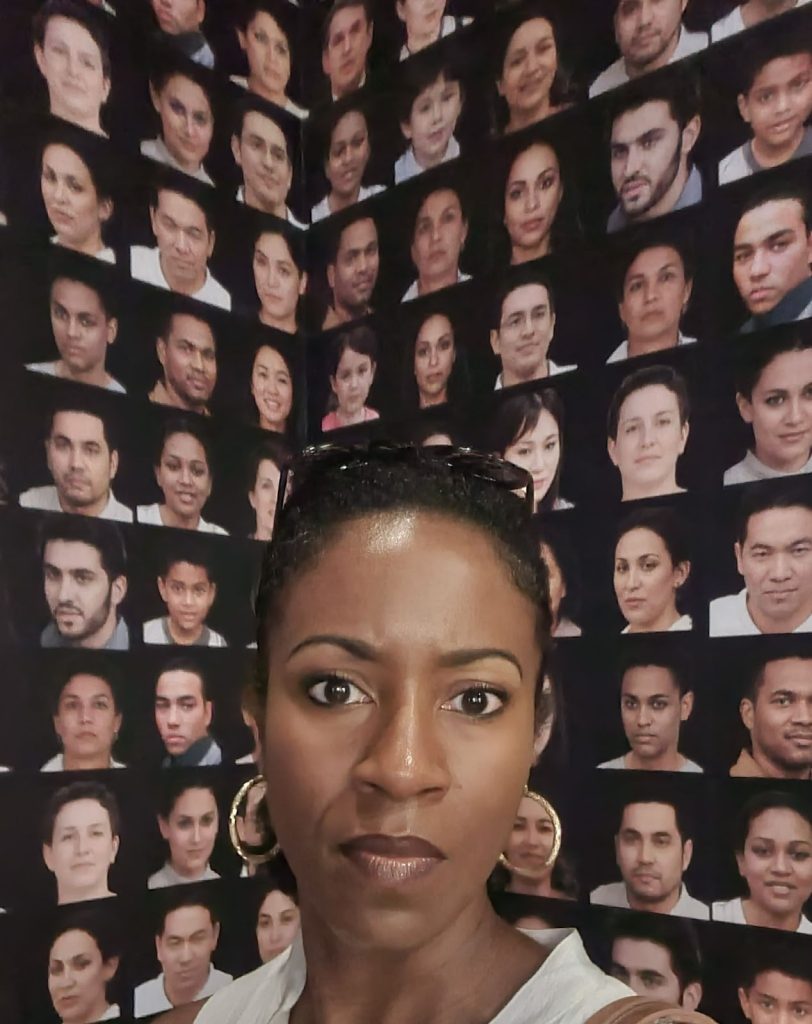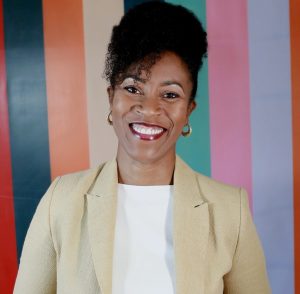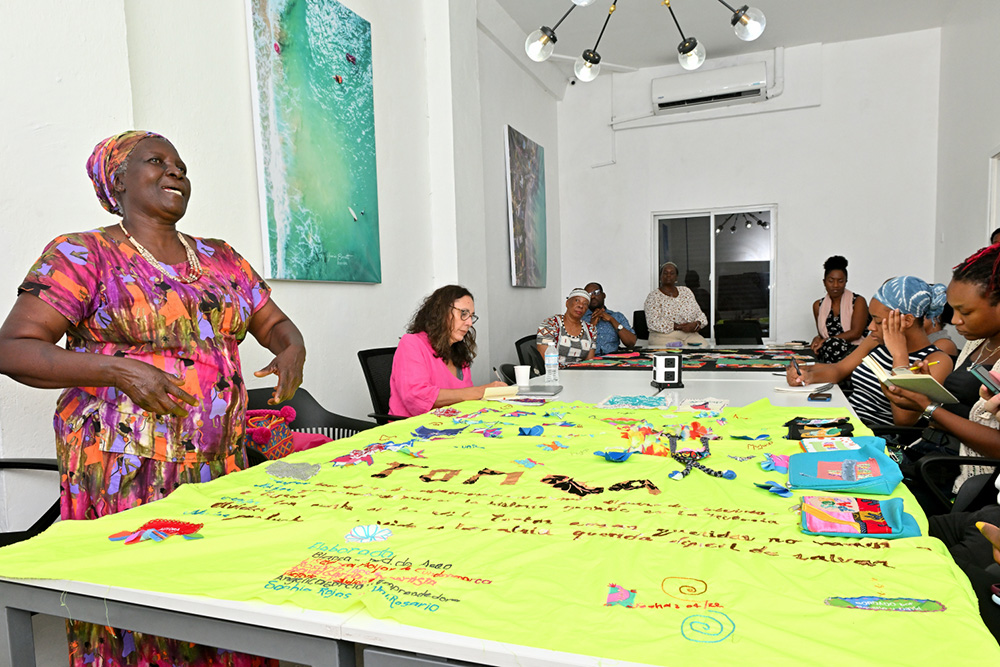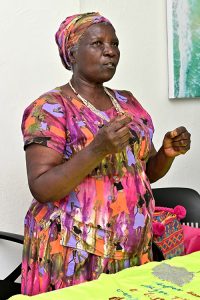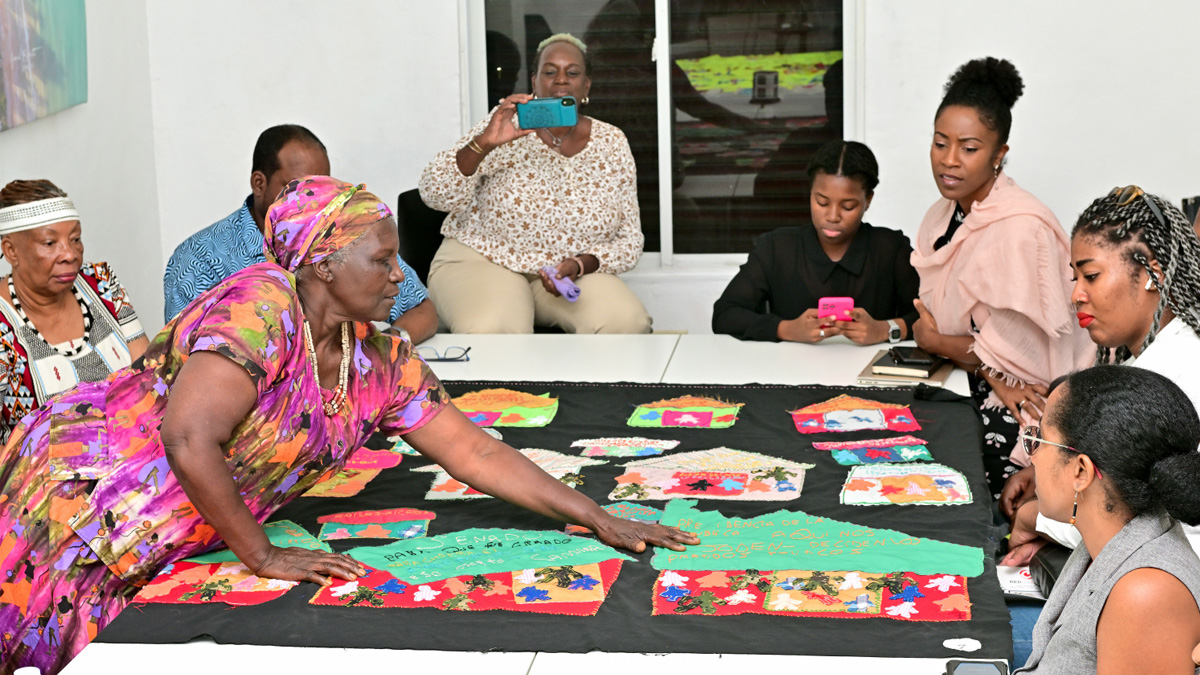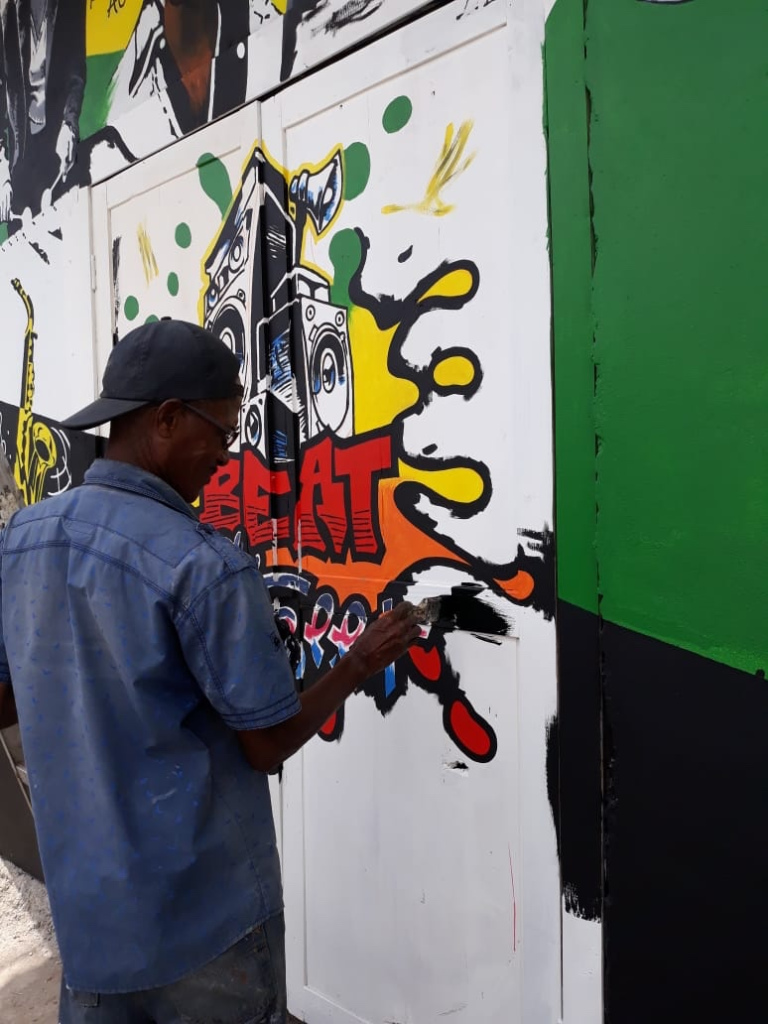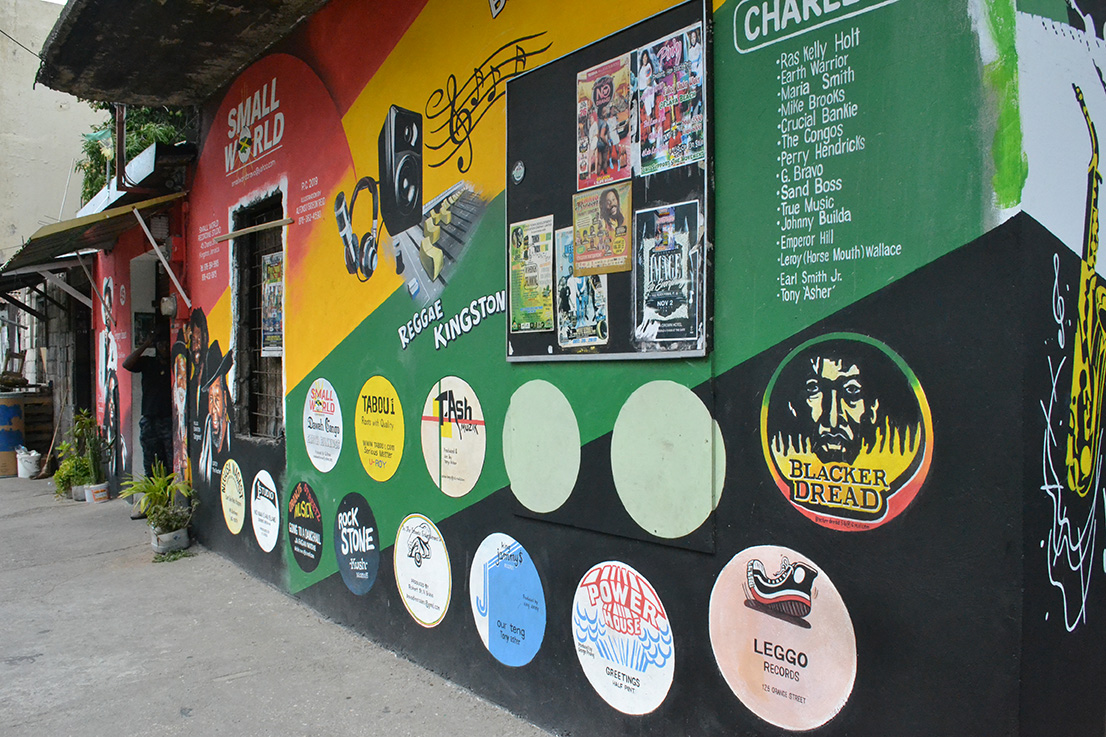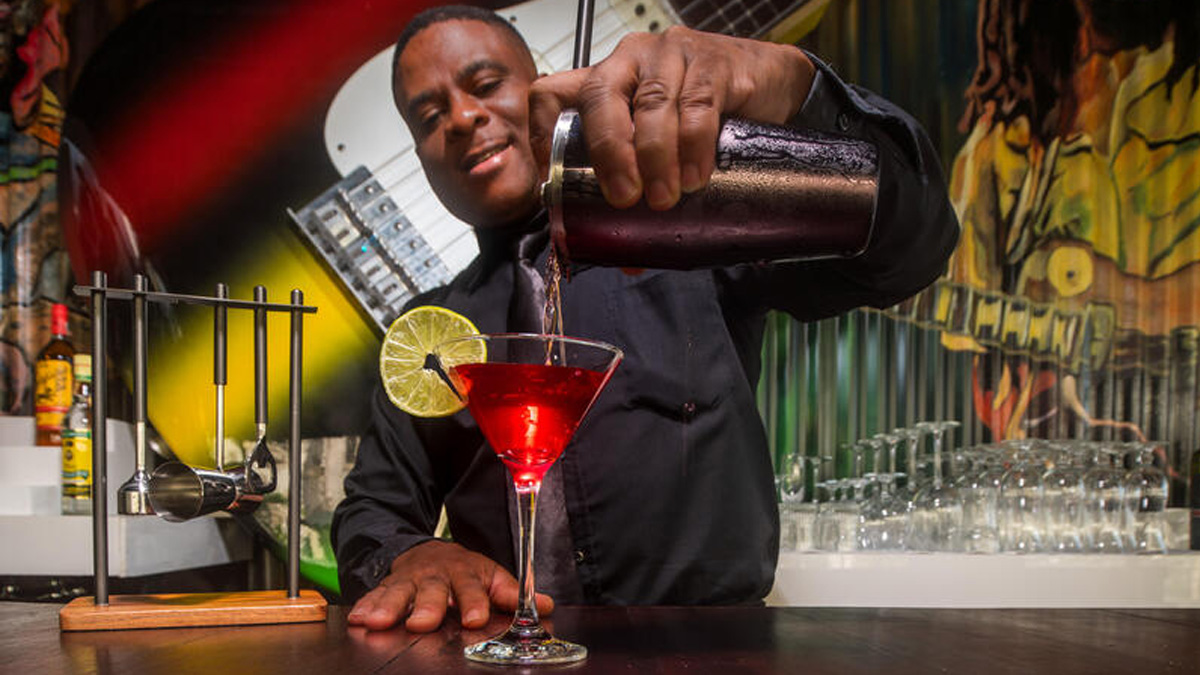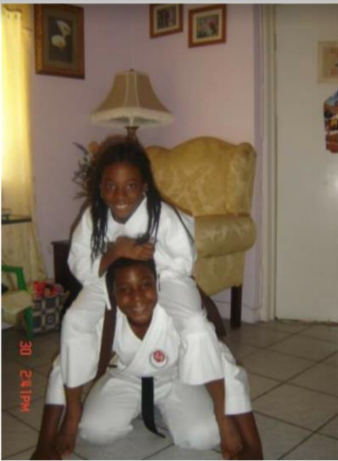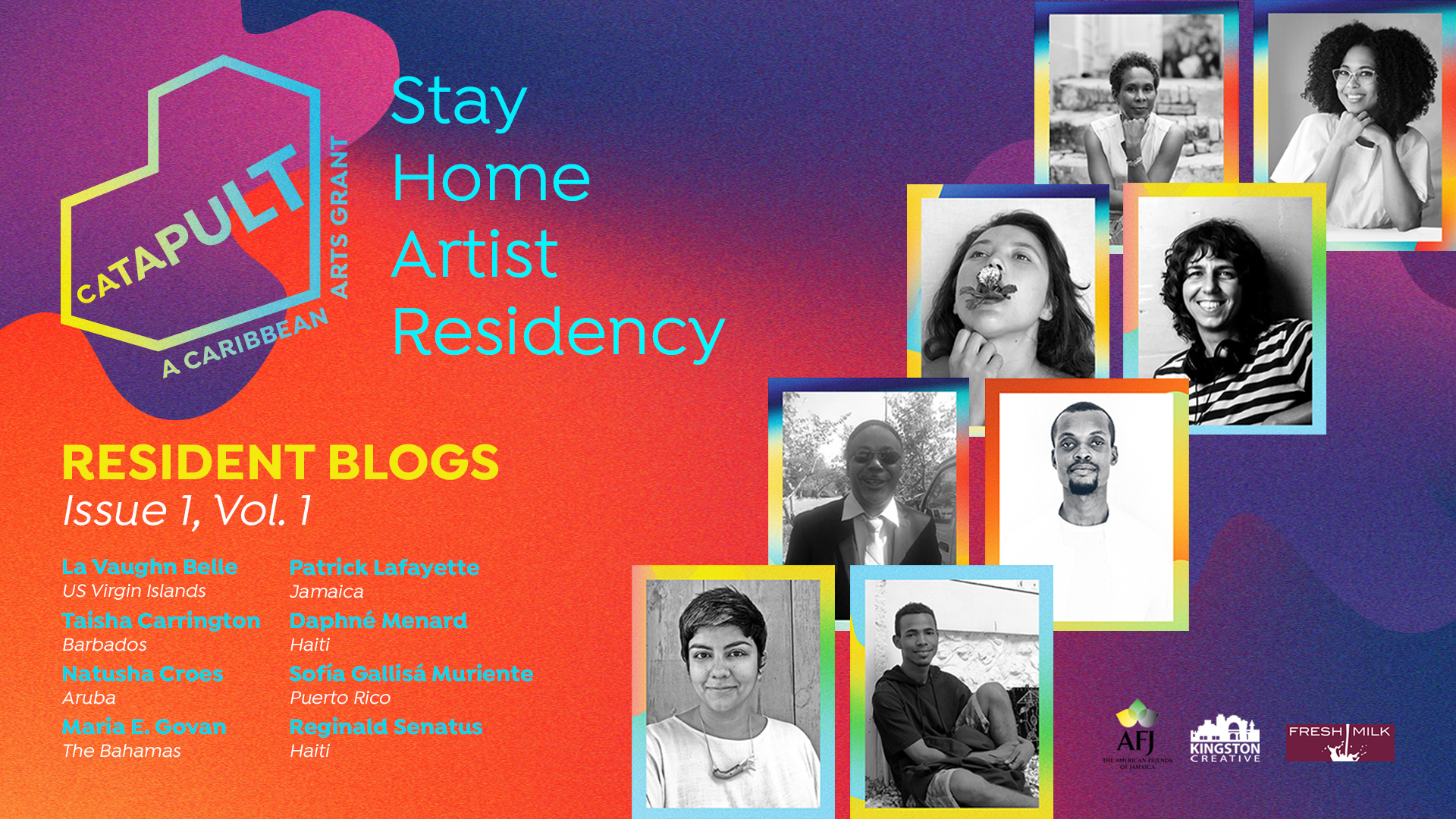31 & Dog Days, A-dZiko Simba
On the last Sunday in June Kingston Creative sponsored my facilitation of an online short story writing workshop as one of their initiatives to keep the arts and artists alive in these surreal times.
And so it was that 7 writers Zoomed into participate in ‘The Good, The Bad and The Kingston’, workshop where using the wonderfully provocative photographs of Donnette Ingrid Zacca, one of Jamaica’s most prominent photographers, we dived into the art and craft of story creation.
The images provided characters and settings and writers fabricated from these, backstories and plots. Over four hours, they produced some compelling work full of the contradictions that are a part of everyday life in our capital city.
My overall aim was to help improve the competencies and confidence of writers by guiding them through a process that was fun, interactive and cooperative. Mission accomplished, I believe. All participants created memorable characters with interesting stories, one of which was clearly morphing into a screen play for a short movie.
Here are two of the stories that were brought to completion after the workshop:
‘31’ – a story by Marleigh Jones, a gritty tale of the life of a young blood just a light scratch below downtown’s surface – his aspirations and pressures juxtaposed against his mother’s dreams.
The second story, written by Holden Hudson, ‘Dog Days’, with its hero, a canine philosopher, explores the opposing pulls of uptown and downtown living.
I am grateful for the support of Kingston Creative in sponsoring the workshop, to all of the participants who showed up with open minds and hearts and especially to Donnette Ingrid Zacca for generously sharing her art.
31 By Marleigh Jones
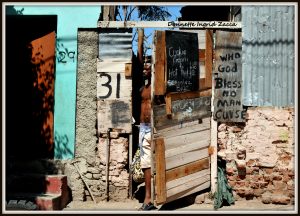
12:00 noon. He rushes from the yard; Mama’s complaint about no shirt fading fast. Dadda needs the glock.
As he flies along the sidewalk, john crows circle elegantly above his head, gliding in the high Kingston breeze that ignores his sinewy frame awash with sweat from the punishing sun.
“Bad man cum firs’.
‘Im doan wait.
‘Im nuh axx nuhbaddi.
Ah im fly di gate…”
He laughs at NikiNax’s song, blaring from a route taxi soliciting passengers, as he remembers being first to ram the girl at initiation.
“Eh bwoy, watch weh y’ah –“
A bus conductor, dangling from a speeding 30-seater, boxes his head as he crosses Orange Street
to the shell of Captain’s Bakery. His fingers move reflexively. They caress the steely hardness of Bad Gyal. Just as quickly, he withdraws, muttering,
“Every puss have him 4 o’clock.”
He marks the escapee and makes note: Rock River to Kingston via Annotto Bay.
In his bag, Bad Gyal anchors layers of baby pampers, and a pair of sneakers. This is topped off by a nice piece of yellow yam from ’31’.
12:10. He sees Brown Man’s cart and thinks he will buy onion, skellion and thyme on the way backto ’31’ for Mama’s soup at 4:00.
Read More ’31’ a story by Marleigh Jones
Dog Days by Holden Hudson

The intoxicating aroma of a stale stout brew vapors from the warm pavement and mixes with marijuana and pan chicken before dancing a ballet of twirls in the air above the street. The aromatics in the air pacify the muscles as the warm breeze of the golden hour relaxes the load for the upcoming night. Plumes of dust balloons from the dry patches at the end of the street like funeral pyres that offer incense to the gods – if they are there. The calm relinquishes to the defeat of a harsh reality that lives in the dangerous fragility of night. This painful tension can often be broken by a cold reality that stabs smoothly through warm belly meat, oozing life-giving juices and straight to the cracking stop of hard white bone. David the dog knew this. David saw it. He tasted it. On occasion he lapped the life substance from the dusty floor of the city streets. Life’s juices often caked his tongue and colored his whiskers brightly betraying what he is really- a dog on the mean streets.
The shrieks of an irreverent small human pierced through David’s abated consciousness like the maddening siren of the Babylonian agents. David sprung to all fours with vengeful disapproval and grappling alarm. There, wrapped in a bosom of love, a small human that instantly melted his heart. The folds of the blanket come undone with a fervent yawn and stretch just enough that he could make out a face of innocence with a nose as cute as a button. The grimacing snarl he had formed with fright dissipated from his face as the growl of annoyance was swallowed into a glottal knot that balled in his throat to be of use in future angry times.
The ‘hoomans’ that looked out for him were decent people. Every morning there was cornmeal cooked with cuttings from the previous night’s dinner. This happened without fail. They knew he worked nights and as such rewarded him with a payment breakfast every morning. Even when the day was one that didn’t see any kitchen activity, there was always a party with a line of pan chicken men with scraps on offer most nights of the week. David always went early so he could get back on duty at home.
Now awakened to be put on guard, he scampered to the shop at the end of the street. Through the misty window he saw a television commercial offering something of a dream.
“Uptown Puppy Chow”, he muttered cynically.
“Perfect k9.”
“Have a shiny coat. Even yet, can see vets in white coats.”
‘’Anyways………..never liked those vets in their white coats. They look too much like butchers to me!’’
David knew in his heart he was a little envious. If he was cut in two at the time, his guts would be green with envy.
“Maybe a bad mind me ketch …..” his thoughts rebounded.
“But a bed inside would be nice”, he thought.
“I deserve it.”
“I deserve nice things.”
“Isn’t it the dream of everyone to get out and have a big house on the hill?”
“Nothing no really wrong with that. I want to travel too yah man,” he said, trying to convince himself.
The yearning of flight returned nine nights later like a slap in the face from the cold hand of death in the balmy night. On that day the pups around the way ran out on the main road before they should have and had a problem with the wheels of a deportee taxi. Or so they would like us to believe. David heard the rumors about the deportee taxis and the pups before. He knew what happened even if no one dared to say it. The system used the vulnerability of the deportee taxi against its own dogs is what really happened. The unofficial word was that one misdirected juvenile bark in the wrong direction and you would be greased then found in nearby bushes. The official word did not mention, holes where eyes once sat eyes, the rat-ta-ta-tat echoing through the darkness nor the whimpering nudges of mothers trying to resuscitate. It’s sad that no one asked why dogs barked. The pups were all guilty by association. They lived in the wrong part of the town. Expendable! “All dogs matter”, David muttered with a conscious inside voice, knowing some ears are more discerning than others.
This dis-ease will not go without recompense. From New Grill to Pork Land, there will be no safe route. The dogs won’t be disrespected. The nervous existence of the deportee taxis is evident in their frantic driving and all dogs are in danger. Even the parking lots where once birthed the deportees, have refused them reentry. Try as they may to make a new life, trouble finds them. A quiet word with dogs would have informed taxis of a safe route, but that didn’t happen. Now being punctured is inevitable.
Somewhere in the heat of the tenth day with the reeking of despair in the air, David resigned concretely that leaving is best. Pushing him to the edge was the sight of the red-hot midday sun mercilessly baking the bodies, allowing the afterlife to envelope gases before contorting flesh and bone. It could have been the sight of vultures, perfumed in the stench of death, swirling and swooping like a black mass that dishonored in life and in death while blotting out the sun to create shadowy dancing omens on the dusty ground.
If he ever wanted to make his move, Jetset was the dog to know. Word on the street was that Jetset knew how to get on the work program and that’s where he went when he was not around. Some saw Jetset as a metropolitan dog of mystery and intrigue. He would disappear for months on end before reemerging in some slightly wiser and some slightly damaged way as well but always with stories to tell. He would regale the pups with stories of sleeping in luxurious rooms, being at pool parties and eating fine gourmet food bought for him and Bella in special cans. He was always talking about having a ‘Bella Blue’ while pausing to look off longingly to the side. He spoke of Bella Blue like a favorite experience more than a K9.
The chat with his brethren went by in a swift businesslike manner. All the details were covered expeditiously. He needed to know the basics of when and where. He should always keep his program card on his person. He had to arrive at a specific place and at a specific time. He should not ask too many questions. He should act natural. He should expect food and a leash. He should not eat too much. An upset stomach while travelling uphill and at altitude is a real bad thing. He should try to relax when his ears start popping at departure and arrival- chewing gum would help. This is normal. If his stomach got upset, he should have a crème soda. A hot one. He will be taken to a vet, but he should not worry unless a white lubricated glove is introduced. He will not be in quarantine, after all the virus doesn’t affect dogs, only cats. This is why no cats were allowed on the program. David paid his three bone program fee, signed his paw print and left Jetset to finish his paperwork. He was leaving for better. He was old enough to know life is short. He had to try, he told himself, he will not be a statistic. He had already paid the fee. It was not just expensive, but it was all he had buried. He had to get out.
Upon arriving, excitement was palpable as David was able to see the whole of Kingston. The lawns were manicured as he thought. The garden was fragrant in bloom. The pool at the back was the perfect temperature and color as it mirrored the mountains set against it. This was pleasant, he thought. David’s eyes opened widely and he realized everything that was as his dream- just like the “Uptown Chows commercial.” The family were decent people– all but one. Back rubs and head scratches as they passed by were an everyday occurrence. He had acted naturally, he didn’t ask too many questions. He followed what Jetset had said and now he was where he wanted to be. He was content, especially since had company. In the car with him uphill to the house was another dreamer who had won the lottery.
In very little time, David realized this mutt was dangerous. Not violent-dangerous, but a kind of manipulative evil that was no good anywhere. He learned to bark with a foreign accent that disturbed the family and made them think they had made the wrong choice. The bark was something that mimicked a Chihuahua and mosquito having a quarrel through a vuvuzela. He walked with a flair, pointy-tailed with erect ears and separated himself from his K9 companion. David was not sure how to put his feelings into words but it caused him great angst. When Mutt heard the family discussing new names, he said something about no longer being a mongrel; but should now be considered being a Royal Jamaican Terrier. David never understood what those words meant but he could always sniff out hypocrisy and pretentiousness, just like all the other dogs from the street. It is an essential skill where he was from. It was a waiting game. No dog can be a hypocrite forever.
The first test of faith came when Mutt told a lie. Mutt could not control his urges and chewed on a Jimmy Choo shoe. They were red-soled and expensive enough to sell three generations of Rottweilers from the security company into servitude for reparations. Mutt forced his hypocrite head into David’s direction even while the red leather needed to be flossed from his incriminating mouth. Every pulsating nerve boiled and a growl from the pit of hell developed in David’s loins. It had a fury to turn Mutt into a rag doll with the stench of death. He only needed a blink in David’s direction to be dismembered. The anger inside broiled in David’s belly but resisted acting.
With his thoughts occupied with anger, David hadn’t seen the undercurrent of Mutts actions. Mutt in an action of incognito fueled maliciousness, and cold dog-hearted deception retreated his hind legs behind the giant couch before contorting his demonic figure to follow behind like a slippery slithering evil toward the location of the dog beds. He had a plan. He had a way to execute his plan. He used the tip of the young master’s shoe lace to frantically floss the guilt-revealing leather from his teeth onto David’s bedding area. While David’s back was turned, Mutt released the most deliberate conniving and mournful whimper that dragged the Masters attention over towards him. The master’s heavy footsteps approached Mutt’s puppy dog eyes that seem to speak volumes in the Master’s mind. David imagined seeing the gears clockwork in his Caretakers brain which then unleashed his anger towards David. On turning the corner of the couch, the scene showed the leather of the expensive shoe all over David’s bed. The Caretaker thought now that David must be a shoe chewer and subsequently Mutt must apparently be a smart dog that is suited for domestic life in the program. This was how lies became reality and falsehood brought bone crushing consequences. This is how many pups are found in Rivertown dump.
Fuming, the Caretaker took three dashing steps toward David. In a deliberate motion, he curved his big right hand under David’s belly and rotated his shoulder rapidly. David remembered the shock of the impact as a heavy heat descended and knocked all the air from his belly through his funneled nostrils. David’s body went limp and nervous as his four feet left a firm stance into a seemingly slow smooth and excruciating maneuver much like the space walk. The visuals from the alarmed children and Kingston’s vista through the glass wall rotated as time slowed just long enough for him to know he had been inflicted a blow of a lifetime and there was nothing he could do about it. He was in a defenseless flight that crashed him into a steel reinforced concrete column on the far side of the living room. He felt his body slap and stick slightly to the flat side of the column with his head askew enough for the column’s sharp edge to feel like he had a razor blade stuck in his throat. Acidic brownish- green and yellow bile burned his stomach lining and came through nostrils and grimaced teeth as a warm red fluid soaked his fur and lined its way down to the marble tiled floor some six feet below him where he gradually slid. He heard his body break like dry twigs, gripped in strong hands; bundled and snapped over an unforgiving knee and felt the stampede of a thousand horses galloping on his mortality. David’s body went limp as the world said goodnight with a blurry kaleidoscope of his utopian dream.
Now exiled to the outside. It was the responsibility of the children to take care of him now even as Mutt lounged spitefully close to David’s full view – right under the air condition unit. He would often jeer David while he was on his recovery walks and stick his tongue out to mimic David’s demise on that awful day. Swallowed rage was a close companion to David.]
Gradually David tried to regain his strength. He chewed blades of grass and the children brought stolen caffenol and added it to his water accompanied by his ration of Uptown Chows. Slowly his stomach settled and his body healed. Eventually he could run the yard especially when the children came home from school. No sooner had the children changed from uniforms, they were both outside with David, playing. It could be on the swing, under the mango tree or lounging by the pool with their tablets. More often than not, to David’s amusement, the children’s Instagram feeds would take them to watching videos with dogs. They even subscribed to the page ‘The Dogs of Kingston’. David would often watch with earnest to see if any of his compatriots were captured along the avenue. He realized that since he’d left, there was an uptick in the war with the insurgent deportee taxis. Many of the dogs had been crushed and many deportees were punctured as a result. There was a true need for ghetto guard dogs, his people needed him. David considered making his way back, after all his life now was comparably worse now that it was before he left home. His former Caretaker had never laid a finger on him. The children loved David but their parents had a preference for Mutt. David was however not worried about this. He had known of many ‘chewers’ and knew it was only a matter of time before he bit off something that he could not chew in the house. He also knew that the Caretaker would regret the day he laid hands on him- that was for sure. Mutt would feel it for sure for framing him also.
It was early one Monday morning when David witnessed the usual efficient buzz through the glass windows from the outside. Homework was being stuffed in bags, and aromatic steam rose from the stove where bacon and eggs were visible. The panels of the doors opened, and an eager child was seen trying to deliver David’s breakfast when suddenly a blood curdling shrill pierced through the air. The blood drained from the child’s face as she dropped the puppy chows and water and joined the family members in a hurried stampede up the stairs before quickly retreating downstairs with clenched noses and nausea imprinted on their appearance. Mutt’s addiction got the better of him! He had not only chewed on the other foot of the Caretakers wife’s shoes but also swallowed her wedding ring and then deposited his bowel movements in the Caretakers all leather executive loafers that he prepared for his board meeting that morning. The lividity on the man’s face was palpable and seemed to change the color of the clouds as he dragged a now bloody Mutt from the house by the throat. Mutt’s was so captivated by fear of his own life, he sullied himself and that was then mixed with bloody regurgitated fluids. After throwing Mutt to the fences, the man of the house was returning to the house when he paused and looked at David with a regret so heavy it transformed his big, strong muscular frame to an embarrassed worm hiding in a cocoon. Clearly he realized that David was never to be blamed in the first place. He should have never hurt David in the first place. He was too quick to anger.
David could not help himself. He laughed so hard his belly shook with a jolly enrichment. Tears came to his eyes as his laughter showed a full mouth of teeth with his joy echoing across the neighborhood. His front paws slapped his tummy as he fell backwards in a fit of unrepentant elation. David’s caretaker was so embarrassed he returned to his house and family with his head hung low. He had to retrace the putrefied steps he made to exile Mutt to the outside.
David realized that he could easily tear this mongrel apart without impunity. He saw this dejected mongrel looking all decrepit and lost in the world. Sinking his teeth in the soft underbelly of whimpering abject fear would be far too easy.
Mutt, now rejected by the dismissive family, tried to cultivate affinity with David but to no avail. “Bredda me couldn’t help me self! Me see plastic or rubber and can’t help but fi bite it up. Is an addiction me have, me swear! It’s a disease. And me never get the help when me ask for it.”
“Shut you mouth bout disease, dog mek fi bite but you nasty! How you fi doo-doo in the man shoes,” David retorted. “A soon pap you neck!” David became so enraged he sprang at Mutts jugular. Mutt had to jump away with all his strength. David only managed to rip the collar from around Mutt’s neck to which Mutt had attached his program card. On the back was a message David had not read before.
IMPORTANT
ANY DOG WANTING REPATRIATION AT ANYTIME SHOULD HOWL THE PROGRAM DOGFATHER AT THE NUMBER BELOW, AND A MOBILE K9 CREW WILL COME TO YOUR AID.
USE HOWLING CODE: 1-888- DOGFATHER
A waft of excitement sprang to David’s weary legs. The following day, brought a buzz from upstairs with attention given to brewed coffee in tall cups, high heels and oxford knotted ties. David tried to communicate his gratitude and his impending decision to be repatriated to the children. He spun in circles and ran back and forth the full length glass wall that overlooked the waterfront of the city. He was rewarded with pats on the head and comments of being a nice dog to his frustration. David asked Mutt for his shift as this would be his last gesture for the kindness he was shown by the children. Mutt was more than happy to oblige and spent the day lounging by the pool but was tormented by his exclusion from David’s plans.
In the cool of the evening, a full moon concaved itself from the east to west. The family was at dinner as he began howling his goodbyes and calling for repatriation in one sonic euphony. They will remember me David realized as they stopped eating to applaud and mimic his tone. This put his heart at ease and gave him impetus to continue howling the code 1-888- DOGFATHER. It did not take long for the other K9 to resonate the code from one house to the next, further and further downhill to the ears of Jetset- The Dogfather. The brotherhood of the K9 was down but not out! Upon receiving the message an alpha team was assembled and sonar positioning established to mount a rescue mission.
With as much fervor as it was received, the message came back up the hill with a directness that comforted and excited all at the same time. David read the message loud and clear as he sat waiting in the cool of the blue night. “No seh nuttin mo’ me dawg! We a farwud fi you, no delay! Tan up right whe you deh seen, nuh move! You no haffie show no ID cyaad dawg, we know you a who, you hear dat! Everybody cyaan wait fi see you dawg! You a reel general from longer time, no feel no way, you a wi bredda, a love we seh straight, hear dat! Real know real! Yah!”
David’s heart was put at ease. His thought turned to the new babies in the homes of his caretakers. He thought of the hope they represented to their parents and to the world. He now knew he was doing his part in providing hope. The cavalry is on its way for the triumphant exit. He had to return to the bosom of love.
Dog Days © Holden Hudson 2020
